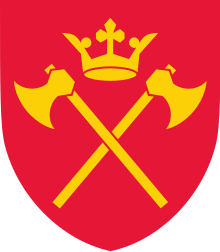Coat of arms of Hordaland: Difference between revisions
m fix red link |
more info |
||
| Line 1: | Line 1: | ||
[[File:Hordaland vapen.svg|thumb|Coat of arms of Hordaland.]] |
[[File:Hordaland vapen.svg|thumb|Coat of arms of Hordaland.]] |
||
The '''coat of arms of [[Hordaland]]''' show two golden axes and a crown in red.<ref name="Coa Hordaland">{{cite web|title=Coat of Arms of Hordaland|url=http://www.hordaland.no/profil/Logo/Namn-fylkesvapen-og-logo/|publisher=Hordaland county|accessdate=20 May 2012}}</ref> |
|||
The '''coat of arms of [[Hordaland]]''' show two golden axes and a crown in red. The arms are derived from the old seal of the guild of St. Olav from Onarheim in [[Tysnes]] municipality. This seal was used by the delegates of [[Sunnhordland]] in 1344 on the document to install king [[Haakon V of Norway]]. It was thus the oldest symbol used for the region and adapted as the arms in 1961. The symbols refer to the patron saint of the guild, [[Saint Olav]], King of Norway, whose symbol is an axe. |
|||
The initiative for a coat of arms for Hordaland was lauched as early as 1918, but the county council waited until 1949 to officialy start the process of adopting a coat of arms.<ref name="Coa Hordaland"></ref> |
|||
The following process took 12 years and the arms were officially granted on December 1, 1961.<ref name="Coa Hordaland"></ref> One or two axes had been used as a royal sybol on Norwegian coins for centuries and the Norwegian Heraldic Authority was considering reserving the crossed axe symbol for the Norwegian stated but eventually released it to the county of Hordaland.<ref name="Coa Hordaland"></ref> |
|||
The arms are derived from the old seal of the guild of [[Saint Olav]], King of Norway, from Onarheim in [[Tysnes]] municipality.<ref name="Coa Hordaland"></ref> This seal was used by the delegates of [[Sunnhordland]] in 1344 on the document issued on July 17 of that year to install king [[Haakon V of Norway]].<ref name="Guild seal">{{cite web|title=Seal of St Olaf guild|url=http://www.hordaland.no/Hordaland-fylkeskommune/Politikk/Fylkesordforaren/Onarheimsseglet/|publisher=Hordaland county|accessdate=20 May 2012|language=Norwegian}}</ref> It was thus the oldest symbol used for the region and adapted as the arms in 1961. The age of the guild is unknown but it is believed to have been in existance in the 10th century.<ref name="Guild seal"></ref> |
|||
The seal was that of the Olavbrothers but was used by delegates to represent all the farmers and populace of Sunnhordland.<ref name="Guild seal"></ref> The main motive of the seal is a coat of arms with a crown over two crossed axes. Almost identical to the current coat of arms.<ref name="Guild seal"></ref> The axe was the holy symbol of saint Olav as he was martyred with an axe. There are two of them to represent [[Olsok]], 29. July and the lesser feast day of saint Olav, 3. August.<ref name="Guild seal"></ref> The crown is the Crown of Saint Olav, King of Norway. |
|||
In the seal the coat of arms was sourounded by the inscription "S'CONVIVARVM: BETI: OLAVI: DE: HONAREI"; The seal of the Guild of Saint Olav on Onarheim.<ref name="Guild seal"></ref> |
|||
The arms were officially granted on December 1, 1961. |
|||
==External links== |
==External links== |
||
| Line 10: | Line 16: | ||
|publisher=www.ngw.nl |
|publisher=www.ngw.nl |
||
}} |
}} |
||
==References== |
|||
{{Reflist}} |
|||
[[Category:Hordaland|Coat of arms]] |
[[Category:Hordaland|Coat of arms]] |
||
Revision as of 18:46, 20 May 2012

The coat of arms of Hordaland show two golden axes and a crown in red.[1] The initiative for a coat of arms for Hordaland was lauched as early as 1918, but the county council waited until 1949 to officialy start the process of adopting a coat of arms.[1] The following process took 12 years and the arms were officially granted on December 1, 1961.[1] One or two axes had been used as a royal sybol on Norwegian coins for centuries and the Norwegian Heraldic Authority was considering reserving the crossed axe symbol for the Norwegian stated but eventually released it to the county of Hordaland.[1]
The arms are derived from the old seal of the guild of Saint Olav, King of Norway, from Onarheim in Tysnes municipality.[1] This seal was used by the delegates of Sunnhordland in 1344 on the document issued on July 17 of that year to install king Haakon V of Norway.[2] It was thus the oldest symbol used for the region and adapted as the arms in 1961. The age of the guild is unknown but it is believed to have been in existance in the 10th century.[2]
The seal was that of the Olavbrothers but was used by delegates to represent all the farmers and populace of Sunnhordland.[2] The main motive of the seal is a coat of arms with a crown over two crossed axes. Almost identical to the current coat of arms.[2] The axe was the holy symbol of saint Olav as he was martyred with an axe. There are two of them to represent Olsok, 29. July and the lesser feast day of saint Olav, 3. August.[2] The crown is the Crown of Saint Olav, King of Norway. In the seal the coat of arms was sourounded by the inscription "S'CONVIVARVM: BETI: OLAVI: DE: HONAREI"; The seal of the Guild of Saint Olav on Onarheim.[2]
External links
- "Norske Kommunevåpen - HORDALAND". www.ngw.nl.
References
